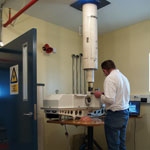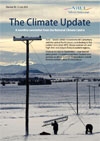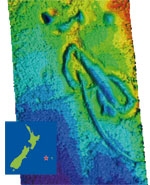PDF of this article (125 KB)



New atmospheric science laboratory in Antarctica
As part of the celebrations of the 50th anniversary of Scott Base, Prime Minister Helen Clark formally opened the new laboratory building at Arrival Heights on 20 January (see Water & Atmosphere 14(2): 8).
NIWA has a range of atmospheric science programmes at Arrival Heights to monitor and understand changing atmospheric composition, using ground-based remote sensing and taking air samples for analysis back in New Zealand. Part of this is monitoring the annual ozone hole and the stratospheric chemistry that leads to it, and part is looking at the concentration and isotopic composition of greenhouse gases (see ‘The Antarctic atmosphere: barometer on a changing world’).
Staff from NIWA began shifting NIWA experiments into the new building in November last year, starting with several spectrometer systems used for ground-based remote sensing of atmospheric composition. These instruments included the venerable Dobson spectrophotometer that measures ozone and the more modern Bruker Fourier transform interferometer that measures several stratospheric trace gases.
During subsequent visits we relocated air-sampling equipment and meteorological instruments and set up and installed a lot of ‘new’ equipment, from roof hatch fittings with windows or domes for the instruments to see through, to a new tower for the meteorology instruments and air-sampling lines.
In the midst of all this activity, NIWA also operated one of its high-precision UV spectro-radiometers for two months to validate UV measurements made at Arrival Heights by US scientists.
‘It’s great to have all our gear housed in a better, more spacious facility. We’ve already seen that the temperature stability of the new building is far better than the old one’, said Stephen Wood, who coordinated much of the move.
The old building was dismantled and packed up just before the Prime Minister’s visit. The Canterbury Museum plans to use a part of it in a reconstruction of an Antarctic research hut.
For further information, contact: Dr Stephen Wood, 0-3-440 0426, [email protected]
Icebergs ahoy!

Bergs were the buzz last November, when several from Antarctica approached the east coast of the South Island. NIWA oceanographer Mike Williams deduced that the icebergs originated at the Ronne Ice Shelf, and isotope analysis done at Otago University has since confirmed this as the most likely source.
During the inaugural voyage of Ocean Survey 20/20 in August, NIWA’s multibeam acoustic survey equipment recorded evidence of icebergs in our waters in the more distant past. The scour marks detected on the seabed on the Chatham Rise were probably made during the last ice age, about 20 000 years ago, according to NIWA marine geologist Scott Nodder. The marks suggest an iceberg measuring between 2 and 5 km long – similar or slightly larger than the biggest berg sighted last year.
For further information, see our iceberg fact sheet: www.niwascience.co.nz/pubs/mr/archive/2006-11-28-1-/iceburg_fact_sheet.pdf
Customary Coastal Management Workshop
21–22 June, Te Papa, Wellington
Increasingly, the regulatory responsibilities for customary management of kaimoana resources and the coastal environment fall upon iwi and managers of taiapure and mātaitai (traditional fishing grounds). In June, NIWA’s National Centres for Coasts & Oceans and Fisheries & Aquaculture will host a two-day workshop at Te Papa in Wellington to highlight how increased scientific knowledge can help.
On the first day, the workshop will identify the key issues and management regimes, and on the second day it will focus on scientific advances that can assist in customary coastal and kaimoana management. Topics will include habitat mapping, resource assessment, fisheries enhancement, and integrated environmental management.
The workshop will be of particular interest to iwi coastal managers, taiapure and mātaitai managers, fisheries managers, resource and environmental planners, and local, regional, and central government policy managers.
For further information, contact: Dr Ian Wright, 0-4-386 0322, [email protected] or see: www.niwascience.co.nz/ncco/workshops/
